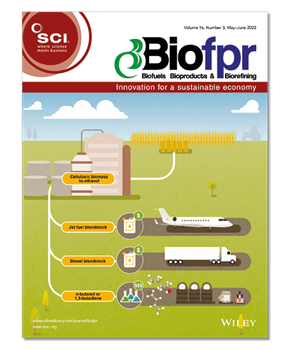Towards multifunctional landscapes coupling low carbon feed and bioenergy production with restorative agriculture: Economic deployment potential of grass-based biorefineries
Sebnem Yilmaz Balaman, Göran Berndes, Christel Cederberg, Håkan Rosenqvist
To read and cite the full paper, please visit:
doi.org/10.1002/bbb.2454
First published: 04 November 2022
WHAT'S IT ABOUT?
A case study in Sweden has shown that green biorefinery (GB) systems could support biomethane and protein feed production, which could reduce the country's reliance on soybean feed imports. Overall, the study highlights the benefits of using grass-based biomass in GBs to support sustainable and environmentally friendly biobased product production.
The paper discusses the potential of using grass-based biomass from grasslands as a feedstock for green GBs to produce a variety of biobased products. By analysing deployment options for GBs, the researchers found that optimising land use changes to increase grass-clover cultivation can yield significant benefits such as carbon sequestration, increased soil productivity, reduced eutrophication, and reduced pesticide use.
From the editor of Biofuels, Bioproducts and Biorefining
Prof Bruce Dale
University Distinguished Professor, MSU AgBioResearch
Michigan State University, US
Humankind needs climate security, food/animal feed, enhanced biodiversity and especially renewable energy with the prosperity that energy use enables. This article demonstrates clearly that properly designed land use systems permit all of these important objectives to be achieved along with many other environmental services.
ABSTRACT
Grass-based biomass from grasslands can be used as feedstock in green biorefineries (GBs) that produce a range of biobased products. In addition, adjustments made as part of crop rotation to increase areas under temporary grasslands can yield benefits such as carbon sequestration, increased soil productivity, reduced eutrophication and reduced need for pesticides. In this paper, a flexible modeling framework is developed to analyze the deployment options for GBs that use grass–clover to produce protein feed and feedstock for bioenergy. The focus is placed on optimal deployment, considering system configuration and operation, as well as land use changes designed to increase grass–clover cultivation on cropland. A case study involving 17 counties in Sweden showed that the deployment of GB systems could support biomethane and protein feed production corresponding to 5–60 and 13–154%, respectively, of biomethane and soybean feed imports to Sweden in 2020.
MEET THE RESEARCHER
Sebnem Yilmaz Balaman
Division of Physical Resource Theory, Department of Space, Earth and Environment, Chalmers University of Technology, Göteborg, Sweden
Why did you choose grass-clover specifically as the rotating crop in this feasibility study?
Previous research (reference can be found in the article) has shown that increased cultivation of grass-clover mixtures in crop rotations dominated by annual crops can have many benefits. The soil carbon content increases, which improves structure and fertility and counteracts global warming. Water retention capacity improves and nutrient losses decrease, lessening eutrophication in aquatic ecosystems. The use of chemicals to control pests and diseases goes down and less synthetic nitrogen fertilizers are needed due to clovers´ natural ability to fix nitrogen. Besides environmental benefits, this reduces input costs for farmers who in addition can benefit from yield improvements.
These positive effects were the main motivation for us to choose grass-clover as the rotating crop, but we are also interested in these crops because innovation in biorefinery processes helps make better use of the high protein content of these crops. So, we wanted to explore the environmental and economic benefit of cultivating more grass-clover to provide feedstock for protein production in green biorefineries, in landscapes where the cultivation of annual crops is very common.
Given the increasing frequency of extreme weather events, how would increasing temperatures and conditions such as drought or flood affect the model you have simulated?
Extreme weather events and resulting natural disasters can impact soils and cultivation conditions negatively, hence reducing production levels for both cereals and grass-clover crops. Economic and market-related parameters (such as crop prices, cultivation costs, costs of agricultural inputs) can also be affected. This means that there is more uncertainty around some model parameters and consequently around modelling results, including both scale and geographic distribution of deployment.
We can explore these uncertainties and fluctuations by varying selected parameters and investigate how changes in cultivation conditions and extreme weather events may affect conditions for deployment of green biorefineries. For example, the economically viable grass price for green biorefinery owners can be investigated in two ways; either the grass price can be handled as an input parameter that is varied in different scenarios, or it can be handled as a variable to be optimised – ie, the model finds the grass price that makes green biorefinery deployment viable.
What would you say is the most important novel finding in this study?
We have shown that there is a significant potential for grass-based biorefineries and protein-soymeal substitution in Sweden. In a scenario where the area under grass-ley cultivation corresponds to one-third of the area currently used to produce cereals we could produce more protein feed than what is currently provided via soybean meal import. The biogas production in the biorefineries could displace more than 10% of the natural gas import to Sweden. We have also shown that deployment conditions depend on geographically varying conditions and on factors that are determined by policies and markets.
The study is also meant to demonstrate the usefulness of the modelling approach to explore the potential of emerging land use and biorefineries solutions and to analyse how existing land use patterns and product prices influence biorefinery configurations, deployment patterns, and economic performance of associated supply chains. We believe that this approach can be useful in relation to policy development and decision-making in businesses that invest in bio-based solutions.
Your study focuses specifically on Sweden, but could the same framework be used in other regions?
Yes, the model is generic and flexible so it can be used for investigating the potential for grass-based biorefineries in other regions and countries. We can also revisit the Swedish case under other context conditions. The model can be used for analyses at different geographical scales and resolutions, and it includes economic and environmental modules that can be modified and extended to include case- or region-specific constraints and parameters.
Insights gained in the present study can also be relevant for other regions with agricultural landscapes similar to those in the part of Sweden that we focused on. Results from another recent study , covering EU27+UK, indicate that grass cultivation in rotations with annual crops can in many places be an attractive option for producing biomass for biorefineries while remediating soil organic carbon losses and other environmental impacts.
What is next for your research?
As we state in the conclusion of our paper, deployment of green biorefinery solutions will require that farmers see good reasons for changing their land use, and markets for biorefinery products need to be established. The price paid for the biomass is of course important, but other factors play a role as well. Some farmers may think that improved soil productivity is important, while others consider grass and clover cultivation as an option in locations where annual crop cultivation is restricted for environmental reasons.
Policy instruments, such as environmental support schemes and payments for carbon sequestration in soils, can also play a role.
So, there exists a multitude of factors to consider, and their relative importance will vary from one place to another. We now use the model to analyse how a suite of such factors together shape the conditions for biorefinery deployment in different locations in Sweden. As an extension, we plan to investigate whether existing technical infrastructure, such as gas pipelines and industrial activities producing surplus heat, may strengthen the case for green biorefineries in specific locations. We also investigate how biorefinery deployment may be affected by extreme prices for agricultural inputs and crops.



